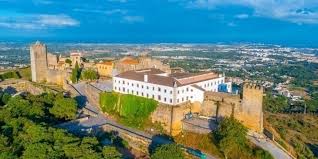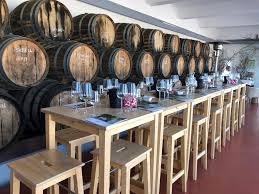
Portugal is renowned for its diverse wine production, encompassing a variety of wine styles across its numerous wine regions. Here are the main types of wines produced in Portugal:
1. Red Wines
- Douro Reds: Known for their complexity and aging potential, often made from a blend of indigenous grape varieties like Touriga Nacional, Tinta Roriz, and Tinta Barroca.
- Dão Reds: Typically elegant and aromatic, frequently made with Touriga Nacional, Jaen, and Alfrocheiro.
- Bairrada Reds: Predominantly made from the Baga grape, known for its acidity and tannic structure.
- Alentejo Reds: Often full-bodied and fruit-forward, made from grapes like Aragonez (Tempranillo) and Trincadeira.
- Lisboa Reds: A mix of traditional varieties and international grapes, producing a wide range from everyday drinkers to premium wines.
2. White Wines
- Vinho Verde Whites: Light and crisp, often with a slight fizz, made from grapes such as Alvarinho, Loureiro, and Trajadura.
- Dão Whites: Generally full-bodied and complex, made from Encruzado and Bical.
- Bairrada Whites: Often fresh and fruity, primarily produced from Bical and Maria Gomes.
- Lisboa Whites: Diverse, ranging from easy-drinking wines to more complex styles, made from grapes like Arinto and Fernão Pires.
- Alentejo Whites: Known for their richness and tropical fruit flavors, made from Antão Vaz, Roupeiro, and Arinto.
3. Fortified Wines
- Port Wine: A fortified wine from the Douro Valley, famous for its sweetness and rich flavors, made from a variety of indigenous grapes.
- Madeira Wine: From the island of Madeira, known for its unique aging process and styles ranging from dry to sweet.
- Marsala: Though primarily associated with Sicily, some fortified wines in Portugal bear similarities.
4. Sparkling Wines
- Espumante: Sparkling wines produced in various regions, notably Bairrada and Lisbon, made using traditional methods or the Charmat method, often with grape varieties like Baga and Arinto.
5. Rose Wines
- Rosé: Produced in several regions, often dry and fruity, made from a blend of red grape varieties. They are popular in regions like Alentejo, Lisboa, and the Douro.
6. Late Harvest and Sweet Wines
- Setúbal Muscat: A sweet wine made from Muscat grapes, known for its aromatic complexity.
- Colheita Tardia: Late-harvest wines from various regions, characterized by their sweetness.
7. Vinho Verde
Region: Vinho Verde is produced in the Minho region, located in the northwest of Portugal. The name “Vinho Verde” translates to “green wine,” which refers to the wine’s youthful character rather than its color.
- Style: Mostly known for its light, refreshing, and slightly effervescent wines, Vinho Verde can be made from both red and white grape varieties. It is typically low in alcohol (usually between 8% to 11.5%) and has a crisp acidity.
Types of Vinho Verde
- White Vinho Verde:
- The most common type, made from grape varieties like Alvarinho, Loureiro, Trajadura, and Arinto.
- White Vinho Verde is characterized by its vibrant acidity, floral aromas, and often a slight spritz that adds to its refreshing quality. It pairs well with seafood, salads, and light dishes.
- Red Vinho Verde:
- Made from grapes such as Vinhão, Borraçal, and Espadeiro.
- Red Vinho Verde tends to be darker in color, fruitier, and also has a refreshing quality, though it is less common than the white varieties.
- Rosé Vinho Verde:
- Produced from red grape varieties, offering the refreshing qualities of white Vinho Verde with some additional fruitiness and color, it has gained popularity in recent years.
Characteristics
- Flavor Profile: White Vinho Verde typically features notes of green apple, citrus fruits, and mineral undertones. The reds often display dark berry flavors with a hint of earthiness.
- Serving: Vinho Verde is often enjoyed chilled, making it an ideal choice for warm weather and casual dining. Its acidity and freshness make it versatile for pairing with a wide variety of foods.
Conclusion
Vinho Verde is a delightful representation of Portugal’s wine diversity. Its unique characteristics and refreshing style make it a favorite among wine lovers, particularly in warmer months or as an aperitif. Whether one enjoys it in a casual setting or as an accompaniment to a meal, Vinho Verde showcases the charm of Portuguese winemaking.
These various wine types reflect Portugal’s unique terroirs, indigenous grape varieties, and winemaking traditions, making it a fascinating country for wine enthusiasts.
Quality classification
Like many other countries, Portugal has established a system to measure the quality of its wine. These are the main categories:
CVR – Wine produced in a specific region using at least 85% locally grown grapes.
Vinho de mesa – Basic table wine; the label often doesn’t specify the region or the grapes used.
VR (Vinho Regional) – This translates as “regional wine.” It’s slightly better than vinho de mesa but doesn’t follow the same strict rules as an IPR or DOC. It allows winemakers to be a bit more flexible with their process and use international grape varieties if they want to.
IPR (Indicação de Proveniência Regulamentada) – Wine made in newer regions waiting to get DOC status. This designation appeared in the 90s as an intermediate quality level, but it’s not that common anymore as most wines fall into one of the other categories.
DOC (Denominação de Origem Controlada) – This is the highest rank for Portuguese wines, equivalent to AOC in France or DOC in Spain. These wines are produced in a specific demarcated region and are subject to strict regulations defined by local wine commissions.




